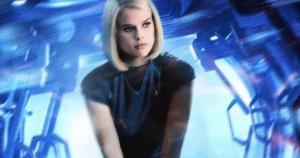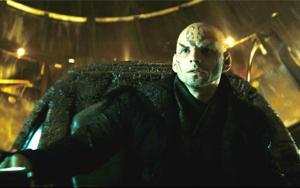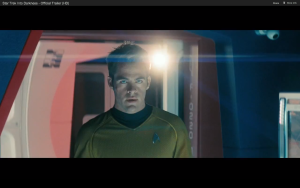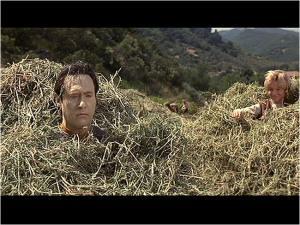There are two different versions of J. J. Abrams’ Star Trek Into Darkness. There is what the film actually is – a competently made summer movie blockbuster with eye-popping special effects, mostly cliched plot developments with a welcome twist or two the internet thankfully failed to spoil, and almost un-ending action. There is, however, what the film isn’t which is to say this is not a Star Trek film.
Or, at least, this is not what Star Trek films used to be. Granted, the special effects are far superior and the cast, for the most part, an equal match to the original. However, there are no real philosophical discussions being engaged with in this film. We aren’t navigating a new technology which literally remake planets (Star Trek II and III), searching for God (Star Trek V), pondering the nature of mortality (Star Trek Generations, Insurrection), or attempting to save an endangered species (Star Trek IV). We are instead barreling forward from action set piece to set piece and being told a story which basically inverts a familiar one told by Gene Rodenberry and company many years ago. The problem, then, is figuring out how to judge Star Trek Into Darkness for what it is and attempting to best ignore what it is not.
*SPECIFIC SPOILERS BELOW INCLUDE A DISCUSSION OF THE BASIC PLOT & A GENERAL REACTION TO THE FILM. NO TWISTS ARE SPOILED.*
The film opens with an incredibly engaging pre-title card sequence involving Capt. Kirk (Chris Pine) and Dr. McCoy (Karl Urban) being chased by an alien planet’s indigenous people while Commander Spock (Zachary Quinto) attempts to use science to minimize the threat posed by an erupting local volcano. Kirk refuses to leave Spock behind when the mission turns south, and his rescue efforts portends big things, both both plot-wise and thematically.
After this re-introduction to our core characters, we get to the real plot of the film which involves a terrorist named John Harrison (Benedict Cumberbatch) who is enacting multiple attacks upon Starfleet for unknown reasons. In response, Captain Kirk and the Enterprise are sent after Harrison by Admiral Marcus (Peter Weller). This places a crew of scientific explorers on a military operation, which at least two characters are willing to point out while everyone else falls in line. However, due to the film’s relentless pacing this and future revelations are not quite granted as much time to sink in as they could have, although one assumes that is by design as the crew is quickly thrown into a constant state of reaction with precious little time for analysis.

Joining the crew on the mission is a new science officer played by Alice Eve. As has been much-discussed, you do see her in her underwear, but if you blink you’ll probably miss it.
It is at this point where the plot twists, some regrettably predictable and some not, creep in. As such, I will offer no further discussion of the actual plot as we will soon be offering a follow-up column to this one devoted to a spoiler-filled discussion of the film.
The plot mostly serves to merely connect one big-budget action set-piece to the next. In that way, it is more than sufficient. The story still invariably centers around Kirk and Spock, as they are truly given all of the heavy lifting, acting-wise, in the film. Quinto, in particular, truly shines, even if some his story developments threaten to upset those who think Spock should only behave in a certain way.
There is at least a clear attempt on hand to give almost all of the primary crew members something new and interesting to do. Uhura’s (Zoe Saldana) relationship with Spock is dealt with more, serving both as a source of humor and unexpected insight and pathos. Scotty (Simon Pegg) becomes integral to the plot, and Sulu (John Cho) and Chekov (Anton Yelchin) each enjoy new roles on the ship. It is unfortunate, then, that Dr. McCoy (Karl Urban), a character so central to the Kirk/Spock/McCoy trio at the heart of the original Star Trek show, is mostly used to poke humor at the public perception of McCoy (i.e., that he mostly speaks in metaphors). Urban is entertaining, as always, although he was given better material in Abrams’ original Star Trek.

Erica Bana as Nero from 2009′s Star Trek. Nero was basically a new version of the infamous Khan from the Original Series and Wrath of Khan, except here he was a Romulan who yelled a lot.
Speaking of which, Abrams’ original Star Trek had a famously undercooked villain. Benedict Cumberbatch, who as others have argued features a name which appears to have emerged from a J.K. Rowling character name generator, emerges as a far more memorable villain than Nero. His infamously deep tenor is used to chilling effect, and he also turns out to be a far more physically imposing presence than expected. The role might prove slightly underwritten, as if (as originally argued by Film School Rejects) “ticking recognizable boxes is a valid substitute for earned emotion,” but Cumberbatch does get one dramatic monolog which he handles with the grace expected of such a stage-tested actor. It is a definite improvement upon Bana’s work as Nero in the original.

Cumberbatch as Harrison from Star Trek Into Darkness. He occasionally dramatically overprounces words to unintended comedic effect, but it is an otherwise stellar performance in a slightly underwritten role.
The aforementioned action set-pieces are legion, though not uniformly engaging. The film relies upon one too many tickling clock sequences (e.g., it’s going to blow in 5,4,3,2…), and somewhat blatantly lifts ideas from both Godfather III and Star Wars, with a recreation of the Millenium Falcon’s race through the Death Star in Return of the Jedi being the most egregious. Though derivative, the scenes are well done. They just pose the potential to disrupt the flow of the narrative for those who might be taken out of a story when they see the copying and pasting at play. However, some of the action in this film is truly and masterfully stunning, with the crash landing of a ship (as highlighted by the film’s marketing campaign) being the standout moment (and actually aided, if just somewhat, by 3D). There are more than enough edge-of-your-seat moments to keep audiences engaged and excited.
Abrams’ directing is, for the most part, on par if maybe a bit less emotionally engaging than that of his original Star Trek. There are some slight pacing issues, as the film seems to suffer somewhat when it has to stop periodically for expository sequences. The editing, at times, is a bit dodgy, but not enough to be distracting. The lens flare, on the other hand, is horribly distracting. For those who don’t know, a lens flare is, as described by the LA Times, the intentional flooding of the “camera frame with light to deliberately wash out or obscure imagery on-screen.” The effect of a lens flare is seen below:

A signature Abrams’ lens flare from 2009′s Star Trek.

A lens flare moment from Star Trek Into Darkness.
The lens flare is Abrams’ signature cinematic touch – the thing that lets you know it is an Abrams film. In explaining his usage of lens flare in Star Trek, Abrams argued (as quoted by io9.com) “I love the idea that the future was so bright it couldn’t be contained in the frame.” He has not backed down from this with Into Darkness, in fact doubling his efforts it would seem. Like anything else, the hope is the eye will adjust to the effect. However, through 3D glasses the lens flare often seems to jump out at you, jarring the viewer even during quiet conversation scenes. Even without 3D, the lens flare undercuts several dramatic scenes, particularly during Alice Eve’s big dramatic speech in the film. There she is, acting her heart out, and there’s a big blue line cutting across the bottom of the screen for no apparent reason. You want to yell out to the non-existent projectionist, “Focus!” until you realize the projectionist is Abrams, and it looks exactly as he designed.
So, what is this film? An enjoyable action film with slight pacing issues, overused lens flare, and a decent story which has a nice twist or two with perhaps slightly too much reliance upon nostalgia. So, what isn’t this film? It’s not particularly fun. There is some humor, with your own personal comedic predilections dictating how much of its works and how much of it doesn’t. However, the sense of discovery from Abrams’ initial Star Trek is mostly absent. Others are now arguing (TIME) whether or not Into Darkness is simply too dark, another example of a franchise caught chasing Christopher Nolan’s cinematic coattails.

Of course, on the other end of the spectrum is something like Data (Brent Spiner) playing with a little kid in Star Trek: Insurrection which is the type of plot probably best left behind.
Again, there is the version of this movie that is an imperfect but completely enjoyable action film. Then there is the version of the film that fails to aspire to be anything more than that. This speaks to audience expectations more than anything else. For what the film actually is, it is worth seeing. For what the film isn’t, though, well, there are nine prior movies and five different TV shows for that.
Four years ago, Abrams stepped in to save the Star Trek franchise from its creative doldrums, drawing a clear line in the sand between what came before and what he was going to do. Franchise canon is simply an idea generator he goes to for potential stories. He will do whatever he dang well pleases with it because this is his story now – not Gene Rodenberry’s. Now, we finally have the sequel, and with him on his way out to take over the Star Wars series we should thank him for reviving the franchise. However, the man who famously doesn’t really like Star Trek and loves Star Wars is probably headed where he belongs. After Into Darkness, it seems likely long-time Trek fans may not miss him. As for those whose introduction to the franchise has been through him, well, it’s not a guarantee he won’t somehow find time to direct a sequel. And a thousand Trekkies just punched the air in frustration.
See It – Stream It – Skip It
See It (although the 3D is not necessary)
That’s Good: Fantastic performances from all involved, both new (Weller, Cumberbatch) and old (Quinto, Cho); truly impressive special effects; action set-pieces are mostly thrilling; composer Michael Giacchino’s musical score is not as memorable as those by prior Star Trek composers Jerry Goldsmith (The Motion Picture and various sequels) and James Horner (Wrath of Khan), but it is rather effective
That’s Bad: Derivative action set-pieces; obstructive use of lens flare undercuts key dramatic moments; mines the past for story ideas it fails to equal or improve upon; poor editing during some action scenes; does not aspire to be anything more than a simple blockbuster action film (only a bad thing if you expect more than that from Star Trek)
Can I Go Now?: Michael Giacchino has composed the score for all of Abrams films as well as his tv shows Felicity, Alias, and Lost. However, he will not be composing Abrams’ Star Wars film. Why? Because John Williams wants to do it, and who says no to John Williams. Also, where else have you heard Giacchino’s name? When he won the Oscar for Best Original Score for ripping our hearts out with the wordless opening montage of Pixar’s Up.
What do you think? Let us know in the comments.

